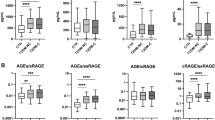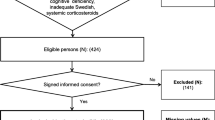Abstract
Aims: To characterize the relationship between advanced glycation end products (AGEs) and circulating receptors for AGEs (RAGE) with cardiovascular disease mortality. Methods: The relationships between serum AGEs, total RAGE (sRAGE), and endogenous secretory RAGE (esRAGE), and mortality were characterized in 559 community-dwelling women, ‡ 65 years, in Baltimore, Maryland. Results: During 4.5 years of follow-up, 123 (22%) women died, of whom 54 died with cardiovascular disease. The measure of serum AGEs was carboxymethyl-lysine (CML), a dominant AGE. Serum CML predicted cardiovascular disease mortality (Hazards Ratio [HR] for highest vs lower three quartiles, 1.94, 95% Confidence Interval [CI] 1.08–3.48, p=0.026), after adjusting for age, race, body mass index, and renal insufficiency. Serum sRAGE (ng/mL) and esRAGE (ng/mL) predicted cardiovascular disease mortality (HR per 1 Standard Deviation [SD] 1.27, 95% CI 0.98–1.65, p=0.07; HR 1.28, 95% CI 1.02–1.63, p=0.03), after adjusting for the same covariates. Among non-diabetic women, serum CML, sRAGE, and esRAGE, respectively, predicted cardiovascular disease mortality (HR for highest vs lower three quartiles, 2.29, 95% CI 1.21–4.34, p=0.01; HR per 1 SD, 1.24, 95% CI0.92–1.65, p=0.16; HR per 1 SD 1.45, 95% CI 1.08–1.93, p=0.01), after adjusting for the same covariates. Conclusions: High circulating AGEs and RAGE predict cardiovascular disease mortality among older community-dwelling women. AGEs are a potential target for interventions, as serum AGEs can be lowered by change in dietary pattern and pharmacological treatment.
Similar content being viewed by others
References
Basta G, Schmidt AM, de Caterina R. Advanced glycation end products and vascular inflammation: implications for accelerated atherosclerosis in diabetes. Cardiovasc Res 2004; 63: 582–92.
Vlassara H, Striker G. Glycotoxins in the diet promote diabetes and diabetic complications. Curr Diabetes Rep 2007; 7: 235–41.
Kilhovd BK, Juutilainen A, Lehto S et al. Increased serum levels of advanced glycation endproducts predict total, cardiovascular and coronary mortality in women with type 2 diabetes: a population-based 18 year follow-up study. Diabetologia 2002; 50: 1409–17.
Bohlender JM, Franke S, Stein G, Wolf G. Advanced glycation end products and the kidney. Am J Renal Physiol 2005; 289: F645–59.
Fu MX, Wells-Knecht KJ, Blackledge JA, Lyons TJ, Thorpe SR, Baynes JW. Glycation, glycoxidation, and cross-linking of collagen by glucose. Kinetics, mechanisms, and inhibition of late stages of the Maillard reaction. Diabetes 1994; 43: 676–83.
Sims TJ, Rasmussen LM, Oxlund H, Bailey AJ. The role of glycation cross-links in diabetic vascular stiffening. Diabetologia 1996; 39: 946–51.
Bucala R, Mitchell R, Arnold K, Innerarity T, Vlassara H, Cerami A. Identification of the major site of apolipoprotein B modification by advanced glycosylation end products blocking uptake by the low density lipoprotein receptor. J Biol Chem 1995; 270: 10828–32.
Schmidt AM, Hori O, Chen JX et al. Advanced glycation end-products interacting with their endothelial receptor induce expression of vascular cell adhesion molecule-1 (VCAM-1) in cultured human endothelial cells and in mice. A potential mechanism for the accelerated vasculopathy of diabetes. J Clin Invest 1995; 96: 1395–403.
Basta G, Lazzerini G, Massaro M et al. Advanced glycation end products activate endothelium through signal-transduction receptor RAGE: a mechanism for amplification of inflammatory responses. Circulation 2002; 105: 816–22.
Nakamura Y, Horii Y, Nishino T et al. Immunohistochemical localization of advanced glycosylation endproducts in coronary atheroma and cardiac tissue in diabetes mellitus. Am J Pathol 1993; 143: 1649–56.
Kume S, Takeya M, Mori T et al. Immunohistochemical and ultrastructural detection of advanced glycation endproducts in atherosclerotic lesions of human aorta with a novel specific monoclonal antibody. Am J Pathol 1995; 147: 654–67.
Vlassara H, Striker LJ, Teichberg S, Fuh H, Li YM, Steffes M. Advanced glycation end products induce glomerular sclerosis and albuminuria in normal rats. Proc Natl Acad Sci USA 1994; 91: 11704–8.
Basta G. Receptor for advanced glycation endproducts and atherosclerosis: from basic mechanisms to clinical implications. Atherosclerosis 2008; 196: 9–21.
Schmidt AM, Vianna M, Gerlach M et al. Isolation and characterization of two binding proteins for advanced glycosylation end products from bovine lung which are present on the endothelial cell surface. J Biol Chem 1992; 267: 14987–97.
Neeper M, Schmidt AM, Brett J et al. Cloning and expression of a cell surface receptor for advanced glycosylation end products of proteins. J Biol Chem 1992; 267: 14998–5004.
Yonekura H, Yamamoto Y, Sakurai S et al. Novel splice variants of the receptor for advanced glycation end-products expressed in human vascular endothelial cells and pericytes, and their putative roles in diabetes-induced vascular injury. Biochem J 2003; 370: 1097–109.
Hudson BI, Harja E, Moser B, Schmidt AM. Soluble levels of receptor for advanced glycation endproducts (sRAGE) and coronary artery disease: the next C-reactive protein? Arterioscler Thromb Vasc Biol 2005; 24: 879–82.
Wautier JL, Zoukourian C, Chappey O et al. Receptor-mediated endothelial cell dysfunction in diabetic vasculopathy: soluble receptor for advanced glycation end products blocks hyper permeability in diabetic rats. J Clin Invest 1996; 97: 238–43.
Geroldi D, Falcone C, Emanuele E. Soluble receptor for advanced glycation end products: from disease marker to potential therapeutic target. Curr Med Chem 2006; 13: 1971–8.
Challier M, Jacqueminet S, Benabdesselam O, Grimaldi A, Beaudeux JL. Increased serum concentrations of soluble receptor for advanced glycation endproducts in patients with type 2 diabetes. Clin Chem 2005; 51: 1749–50.
Tan KCB, Shiu SWM, Chow WS, Leng L, Bucala R, Betteridge DJ. Association between serum levels of soluble receptor for advanced glycation end products and circulating advanced glycation end products in type 2 diabetes. Diabetologia 2006; 49: 2756–62.
Sakurai S, Yamamoto Y, Tamei H et al. Development of an ELISA for esRAGE and its application to type 1 diabetic patients. Diabetes Res Clin Pract 2006; 73: 158–65.
Kalousová M, Hodková M, Kazderová M et al. Soluble receptor for advanced glycation end products in patients with decreased renal function. Am J Kidney Dis 2006; 47: 406–11.
Koyama H, Shoji T, Fukumoto S et al. Low circulating endogenous secretory receptor for AGEs predicts cardiovascular mortality in patients with end-stage renal disease. Arterioscler Thromb Vasc Biol 2007; 27: 147–53.
Kass DA, Shapiro EP, Kawaguchi M et al. Improved arterial compliance by a novel advanced glycation end-product crosslink breaker. Circulation 2001; 104: 1464–70.
Little WC, Zile MR, Kitzman DW, Hundley WG, O’Brien TX, deGroof RC. The effect of alagebrium chloride (ALT-711), a novel glucose cross-link breaker, in the treatment of elderly patients with diastolic heart failure. J Card Fail 2005; 11: 191–5.
Negrean M, Stirban A, Stratmann B et al. Effects of low- and high-advanced glycation endproduct meals on macro- and microvascular endothelial function and oxidative stress in patients with type 2 diabetes mellitus. Am J Clin Nutr 2007; 85: 1236–43.
Guralnik JM, Fried LP, Simonsick EM, Kasper D, Lafferty ME. The Women’s Health and Aging Study: Health and Social Characteristics of Older Women with Disability. Bethesda, MD, National Institute on Aging. NIH Publication No. 95-4009, 1995.
Folstein MF, Folstein SE, McHugh PR. “Mini-Mental State” A practical method for grading the cognitive state of patients for the clinician. J Psychiatr Res 1975; 12: 189–98.
International Classification of Diseases. Ninth revision, clinical modification. Washington, D.C., U.S. Health and Human Services, Centers for Disease Control and Prevention, Centers for Medicare and Medicaid Services, 2006.
Reddy S, Bichler J, Wells-Knecht KJ, Thorpe SR, Baynes JW. N epsilon-(carboxymethyl)lysine is a dominant advanced glycation end product (AGE) antigen in tissue proteins. Biochemistry 1995; 34: 10872–8.
Boehm BO, Schilling S, Rosinger S et al. Elevated serum levels of Ns-carboxymethyl-lysine, an advanced glycation end product, are associated with proliferative diabetic retinopathy and macular oedema. Diabetologia 2004; 47: 1376–9.
Zhang X, Frischmann M, Kientsch-Engel R et al. Two immunochemical assays to measure advanced glycation end-products in serum from dialysis patients. Clin Chem Lab Med 2005; 43: 503–11.
James PT, Leach R, Kalamara E, Shayeghi M. The worldwide obesity epidemic. Obes Res 2001; 9 (Suppl. 4): 228S–33.
Levey AS, Bosch JP, Lewis JB, Greene T, Rogers N, Roth D. A more accurate method to estimate glomerular filtration rate from serum creatinine: a new prediction equation. Ann Intern Med 1999; 130: 461–70.
Goldberg T, Cai W, Peppa M et al. Advanced glycoxidation end products in commonly consumed foods. J Am Diet Assoc 2004; 104: 1287–91.
Koschinsky T, He CJ, Mitsuhashi T et al. Orally absorbed reactive glycation products (glycotoxins): an environmental risk factor in diabetic nephropathy. Proc Natl Acad Sci USA 1997; 94: 6474–9.
Vlassara H, Palace MR. Diabetes and advanced glycation end-products. J Intern Med 2002; 251: 87–101.
Vlassara H, Cai W, Crandall J et al. Inflammatory mediators are induced by dietary glycotoxins, a major risk factor for diabetic angiopathy. Proc Natl Acad Sci USA 2002; 99: 15596–601.
Cai W, He JC, Zhu L et al. Reduced oxidant stress and extended lifespan in mice exposed to a low glycotoxin diet: association with increased AGER1 expression. Am J Pathol 2007; 170: 1893–902.
Wagner Z, Molnár M, Molnár GA et al. Serum carboxymethyllysine predicts mortality in hemodialysis patients. Am J Kidney Dis 2006; 47: 294–300.
Koyama Y, Takeishi Y, Arimoto T et al. High serum level of pentosidine, an advanced glycation end product (AGE), is a risk factor of patients with heart failure. J Cardiac Fail 2007; 13: 199–206.
Humpert PM, Djuric Z, Kopf S et al. Soluble RAGE but not endogenous secretory RAGE is associated with albuminuria in patients with type 2 diabetes. Cardiovasc Diabetol 2007; 6: 9.
Uribarri J, Cai W, Peppa M et al. Circulating glycotoxins and dietary advanced glyation endproducts: two links to inflammatory response, oxidative stress, and aging. J Gerontol A Biol Sci Med Sci 2007; 72: 427–33.
Author information
Authors and Affiliations
Corresponding author
Rights and permissions
About this article
Cite this article
Semba, R.D., Ferrucci, L., Sun, K. et al. Advanced glycation end products and their circulating receptors predict cardiovascular disease mortality in older community-dwelling women. Aging Clin Exp Res 21, 182–190 (2009). https://doi.org/10.1007/BF03325227
Received:
Accepted:
Published:
Issue Date:
DOI: https://doi.org/10.1007/BF03325227




